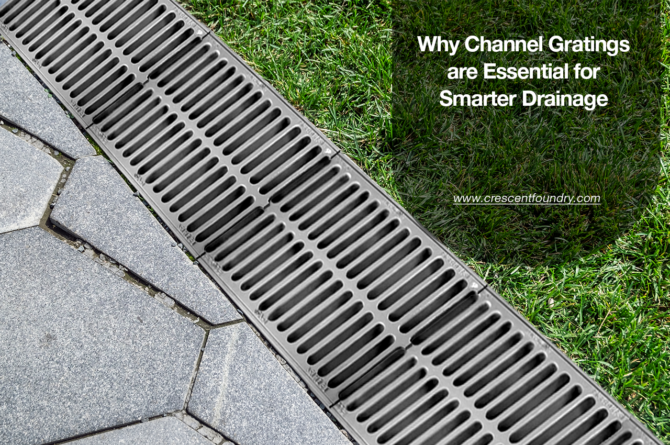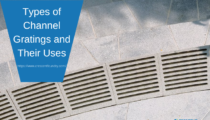Ports work as the bustling arteries of global commerce, connecting…

Why Channel Gratings are Essential for Smarter Drainage
A common construction element, channel drains are used the world over for numerous purposes and called by several other names such as trench and linear drains. Channel drainage works primarily based on gravity wherein, the drained fluids shifts from an elevated level towards the base level. Accordingly, channel drains should be positioned at points where the surface water is most likely to roll towards. This is not an uphill point, but should be more like a crevice in the ground where surface water would flow to, accumulate, and drain from thereafter. Considered one of the most effective drainage solutions, these systems with channel gratings form the central asset of residential and commercial fluid percolation systems.
As you assess the benefits of installing channel gratings to prevent your area from getting swamped with flow water during the peak of monsoon, note the classifications that these drainage systems are based upon. The two broad routes of understanding channel gratings are by considering its building material and its slot designs. In materials used, you can find gratings in –
- Plastic (HDPE) – To ensure lightweight, corrosion-free grates
- Cast Iron & Ductile Iron – For a heavier, more durable solution
- Stainless Steel – For highly chemical-resistant moulds
- Carbon Glass – For weather-resistant, strong frameworks
- Aluminium – For a rust-free gratings in the outdoors
- Fibreglass – To ensure abrasion-resistance, non-slip gratings with a very long lifespan
- Concrete – For greater flexibility in terms of slope, size, and depth
- Reinforced Stone – To ensure higher slip resistance and less heat absorption
According to grating styles, channel systems can be further availed in the following categories –
- Mesh Grating – With criss-cross patterned slots, these keep much of debris out while allowing maximum water passage
- Diagonally Slotted Grating – These feature diagonal bars, ensuring high volumes of water passage, typically used in swimming pools.
- Solid Grating – Featuring slit-like slots for water to escape, these are ideal for semi-indoor spaces where water volume would be minimal.
- Decorative Slotted Grating – All the aforementioned grating styles are made available in designs that add aesthetic appeal, useful for installing in highly visible applications.
Keep Reading: Types Of Channel Gratings And Their Uses
Benefits of Channel Gratings
Typically effective for stormwater disposal, channel drains also serve a clutch of different other applications. Choosing a grating ideal for a unique requirement for your space is therefore essential. The top channel grating manufacturers in India ensure the following benefits with different grating systems –
Flood Control
Whether you are installing channel drains for your underground spaces where water seepage is prevalent during the rainy months or in a semi-covered area like a terrace garden, channel drains with the right type of grating will save you the trouble of excess water sweeping every day.
Water run-off will stay under definite control with gratings of a strong, durable, and weather-resistant nature. Most commonly, gratings used for channel drainage in basements and crawl spaces for modern buildings are of plastic or a stainless alloy like steel or aluminium. While plastic gratings would be cheaper, they are unlikely to ensure a long lifespan.
Other than water run-off control in basements and crawl spaces, gratings for flood water control are also relevant for between wall spaces. You can prevent some serious moulding damage and damping in the walls caused from the typical wetness experienced during the rainy season.
Many homeowners with older-style houses are adapting to channel gratings of weather-resistant nature to avoid flooding damage as reupholstering drainage in certain parts of the house is totally within the service range of home improvement organisations.
Channel Stormwater Away
One of the primary functions of drainage systems with different levels of fluid percolation channels is to orient stormwater in the right direction from the get go. Channel sewers let stormwater collect and flow outside of or under your property, ensuring no stagnant water within the property.
This function serves the purpose of channelling out not just excess stormwater but also sewage. With the apt gratings, home owners can actually modulate the flow span of fluids and thus make sure of speedy drainage. For clear, debris-free stormwater to pass, gratings with larger openings are ideal, while the material used could be of a lightweight nature, like plastic or fibreglass.
On the other hand, for human waste sewage purposes and debris clearance, you may want to choose fine-pored gratings, preferably of reinforced stone or cement so as to put up more resistance against solids flowing on high currents.
Adaptable for Different Types of Spaces
Channel drains with gratings are adaptable for any kind of space where water drainage is necessary. You can even install drainage in your kitchen, bathrooms, and bedrooms too where cleaning would be made easy with a drainage system in place. With the right kind of grating, there would be no risk of small animals like rats, ferrets, or moles entering your indoor areas and with fine mesh gratings, you can keep away insects too.
Channel drainage with gratings is the advanced way to drain away sludge and stormwater, keeping your home clean and your family safe




